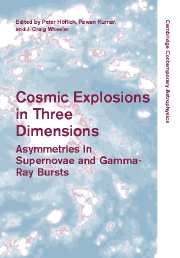Book contents
- Frontmatter
- Contents
- Part I Introduction
- Part II Supernovae: Observations Today
- Part III Theory of Thermonuclear Supernovae
- Part IV Theory of Core Collapse Supernovae
- Part V Magnetars, N-Stars, Pulsars
- 30 Supernova remnant and pulsar wind nebula interactions
- 31 X-ray signatures of supernovae
- 32 Neutron star kicks and supernova asymmetry
- 33 Triggers of magnetar outbursts
- 34 Turbulent MHD jet collimation and thermal driving
- 35 The interplay between nuclear electron capture and fluid dynamics in core collapse supernovae
- Part VI Gamma-ray Bursts
- Part VII Conference Summary
- References
30 - Supernova remnant and pulsar wind nebula interactions
Published online by Cambridge University Press: 11 August 2009
- Frontmatter
- Contents
- Part I Introduction
- Part II Supernovae: Observations Today
- Part III Theory of Thermonuclear Supernovae
- Part IV Theory of Core Collapse Supernovae
- Part V Magnetars, N-Stars, Pulsars
- 30 Supernova remnant and pulsar wind nebula interactions
- 31 X-ray signatures of supernovae
- 32 Neutron star kicks and supernova asymmetry
- 33 Triggers of magnetar outbursts
- 34 Turbulent MHD jet collimation and thermal driving
- 35 The interplay between nuclear electron capture and fluid dynamics in core collapse supernovae
- Part VI Gamma-ray Bursts
- Part VII Conference Summary
- References
Summary
Abstract
I review several topics in the structure of supernova remnants. Hydro-dynamic instabilities in young remnants may give rise to the cellular structure that is sometimes observed, although structure in the ejecta might also play a role. The presence of ejecta close to the forward shock front of a young remnant can be the result of ejecta clumps or the dynamical effects of cosmic rays. Slower moving ejecta clumps can affect the outer shock structure of older remnants such as Vela. Young remnants typically show a circular structure, but often have a one-sided asymmetry; the likely reasons are an asymmetric circumstellar medium, or pulsar velocities in the case of pulsar wind nebulae. In older remnants, asymmetric pulsar wind nebulae can result from asymmetric reverse shock flows and/or pulsar velocities.
Introduction
Observations of supernova remnants frequently show complex structure that can have its origin in several ways: structure in the freely expanding ejecta, structure in the surrounding medium, and the growth of instabilities that result from the interaction of the supernova with its surroundings. If we are to infer properties of the initial explosion from the supernova remnant, consideration of these various influences is necessary. Pulsar wind nebulae (PWNe) provide an additional probe inside a supernova remnant and can lead to an asymmetry because of a pulsar velocity. Here, I review studies of these phenomena.
Instabilities in young remnants
The basic instability that results from the deceleration of the supernova ejecta by the surrounding medium is related to the Rayleigh-Taylor instability.
- Type
- Chapter
- Information
- Cosmic Explosions in Three DimensionsAsymmetries in Supernovae and Gamma-Ray Bursts, pp. 263 - 269Publisher: Cambridge University PressPrint publication year: 2004



